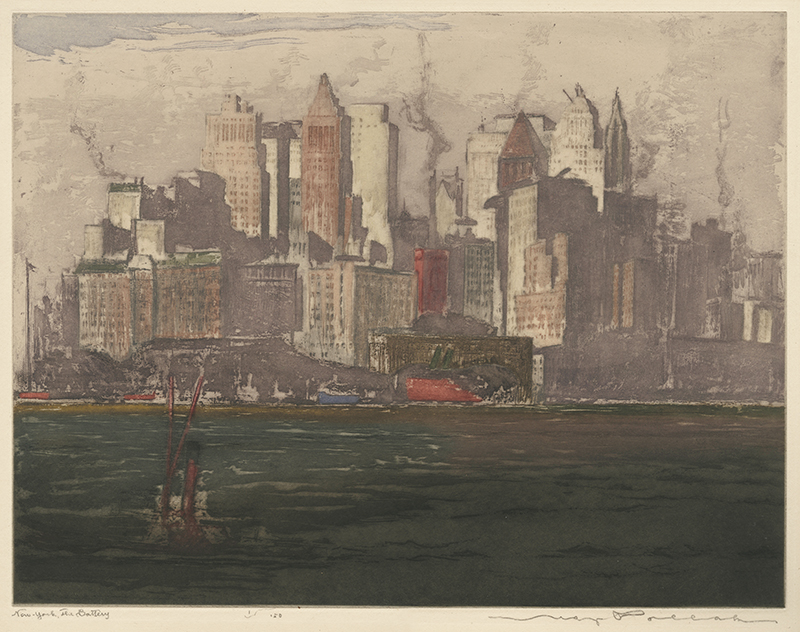New York: The Battery is color etching and aquatint created about 1927 by Max Pollak. It is pencil signed, titled and editioned 1/150 (edition was never completed). This impression was printed by the artist on ivory wove paper and the platemark measures 12-3/8 x 16-1/8 inches. New York: The Battery is no. 109 on the checklist of titles included in Pollak’s 1949 exhibition at the University of California, Berkeley.
The Battery, a twenty-five-acre public park located at the southern tip of Manhattan Island, has been an invaluable part of New York City’s history. In 1626, Fort Amsterdam was built on the shores of The Battery and it served for thirty-eight years as the administrative headquarters for the Dutch West India Company. In 1664, the British sailed to New Amsterdam with four ships and demanded the settlement’s surrender by Director Peter Stuyvesant. In 1665, the British renamed the colony New York, after the Duke of York. Battery Park and the surrounding area is named for the artillery batteries that were built in the late 17th century to protect the settlement. The fort had several name changes over the years but after the Revolutionary War it was demolished and a public promenade was built. In the mid 19th century, Castle Garden became one of the premier sites for arts and entertainment in the city and, in 1855, it became the world’s first immigrant depot. Decades before Ellis Island was built or the Statue of Liberty was gifted from France, millions of people arrived at The Battery and were processed at the Castle, a circular sandstone fort within Battery Park. Among the notable Americans to pass through Castle Garden are Nikola Tesla, Harry Houdini, Emma Goldman, and Joseph Pulitzer. In 1896, the New York Aquarium opened at its first location in the Battery’s Castle Clinton (renamed in honor of Dewitt Clinton, Mayor and Governor of New York). Today, ferries dock at the shores of The Battery to pick up visitors to the Statue of Liberty and Ellis Island.
Max Pollak, painter and printmaker, was born in Prague, Czechoslovakia in 1886. He was raised in Vienna and, in 1902, he entered the Vienna Academy of Art where he studied under William Unger and Ferdinand Schmutzer. In 1912, Pollak traveled to Italy, France, and Holland to study and paint. During the First World War, he was appointed painter of the Austrian Army.
He immigrated to the United States in 1927, living for a time on the east coast where he produced a series of color aquatints of New York, Cincinnati, and Detroit. His first exhibition was at the 57th Street Art Gallery in New York and he was commissioned by Theodore Dreiser in 1929 to illustrate his book, My City. In 1938, Pollak and his wife, Friedl, moved to San Francisco, California. Pollak was inspired by his new city and its environs and produced beautiful views of San Francisco Bay Area. Later travels included trips to Mexico and Guatemala.
Max Pollak was a member of the Chicago Society of Etchers and the California Society of Etchers. His work is represented in the collections of the Magnes Collection of Jewish Art and Life, Berkeley, California; the Jordan Schnitzer Museum of Art, University of Oregon, Eugene; the British Museum, London; the Metropolitan Museum of Art and the New York Public Library, New York; the Oakland Museum of California Art; the Fine Arts Museums of San Francisco, California; and the Smithsonian American Art Museum, Washington, D.C.



